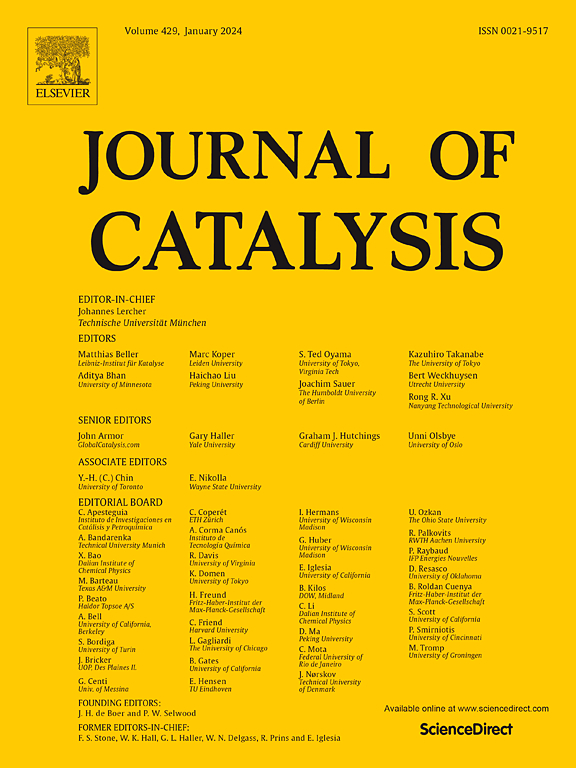苯加氢和环己烷脱氢双原子Pd2催化剂的性能研究:DFT和微动力学模型研究
IF 6.5
1区 化学
Q2 CHEMISTRY, PHYSICAL
引用次数: 0
摘要
芳烃的加氢和脱氢在“液态有机氢载体”(lohc)储氢概念中起着重要作用。本研究采用周期性DFT计算结合微动力学模型研究了苯/环己烷体系的催化加氢和脱氢反应,该体系可以理解为最简单的LOHC体系。所考虑的催化剂是由掺杂氮的缺陷石墨烯支撑的Pd2结构。虽然整个过程是高度放热的,反应能为−2.89 eV,加氢途径单反应势垒最高仅为1.07 eV,但加氢过程效率较低,只生成少量1,2-二氢苯(12B)。这与催化剂上有限的吸附位点有关,这使得反应物的共吸附具有挑战性,因为H2的吸附促进了苯的脱附,反之亦然。我们进一步研究了环己烷、1,2,3,4-四氢苯(1234B)和12B的脱氢反应。在模拟中,所考虑的脱氢过程只导致两个氢原子的去除,而不是完全脱氢。这再次与有限的吸附位点有关:C-H键的激活以及随后h原子向金属侧的转移削弱了催化剂与有机中间体之间的相互作用,导致后者在继续脱氢之前解吸。这项工作的结果强调了考虑吸附位点的可用性的重要性,特别是在使用单原子或少原子催化剂时。虽然对于lohc的概念来说,无法催化完全脱氢是一个问题,但对于化学工业中另一个重要过程——选择性脱氢,所考虑的Pd2催化剂可能是有趣的。本文章由计算机程序翻译,如有差异,请以英文原文为准。

Exploring the performance of dual-atom Pd2 catalysts for benzene hydrogenation and cyclohexane dehydrogenation: A DFT and microkinetic modeling study
Hydrogenation and dehydrogenation of aromatics play an important role in the hydrogen storage concept referred to as “liquid organic hydrogen carriers” (LOHCs). This work uses periodic DFT calculations in combination with microkinetic modeling to investigate the catalytic hydrogenation and dehydrogenation of the benzene/cyclohexane system, which can be understood as the simplest LOHC system. The considered catalyst is a Pd2 structure supported on N-doped, defective graphene. Although the overall process is, with a reaction energy of −2.89 eV, highly exothermic, and the highest barrier for single reactions along the hydrogenation pathway is only 1.07 eV, the hydrogenation process is rather ineffective and only leads to the formation of a small amount of 1,2-dihydrobenzene (12B). This is related to the limited number of adsorption sites on the catalyst, which makes the co-adsorption of the reactants challenging, as the adsorption of H2 facilitates the desorption of benzene and vice versa. We further studied the dehydrogenation of cyclohexane, 1,2,3,4-tetrahydrobenzene (1234B) and 12B. In the simulations, the considered dehydrogenation processes only lead to the removal of two hydrogen atoms instead of full dehydrogenation. This, again, is related to the limited adsorption sites: the activation of the C–H bonds and subsequent transfer of the H-atoms to the metal side weakens the interaction between the catalyst and the organic intermediate, resulting in the desorption of the latter before it can continue to dehydrogenate. The results of this work highlight the importance of considering the availability of adsorption sites, particularly when working with single- or few-atom catalysts. Though the inability to catalyze the full dehydrogenation is a problem for the concept of LOHCs, the considered Pd2 catalyst may be interesting for selective dehydrogenation, another important process in the chemical industry.
求助全文
通过发布文献求助,成功后即可免费获取论文全文。
去求助
来源期刊

Journal of Catalysis
工程技术-工程:化工
CiteScore
12.30
自引率
5.50%
发文量
447
审稿时长
31 days
期刊介绍:
The Journal of Catalysis publishes scholarly articles on both heterogeneous and homogeneous catalysis, covering a wide range of chemical transformations. These include various types of catalysis, such as those mediated by photons, plasmons, and electrons. The focus of the studies is to understand the relationship between catalytic function and the underlying chemical properties of surfaces and metal complexes.
The articles in the journal offer innovative concepts and explore the synthesis and kinetics of inorganic solids and homogeneous complexes. Furthermore, they discuss spectroscopic techniques for characterizing catalysts, investigate the interaction of probes and reacting species with catalysts, and employ theoretical methods.
The research presented in the journal should have direct relevance to the field of catalytic processes, addressing either fundamental aspects or applications of catalysis.
 求助内容:
求助内容: 应助结果提醒方式:
应助结果提醒方式:


